Overnight New York Style Bagels
These bagels are chewy, crusty and properly dense New York Style Bagels. The overnight rise creates the perfect texture and flavor – and you’ll have fresh, hot bagels for breakfast or brunch less than an hour after getting out of bed.
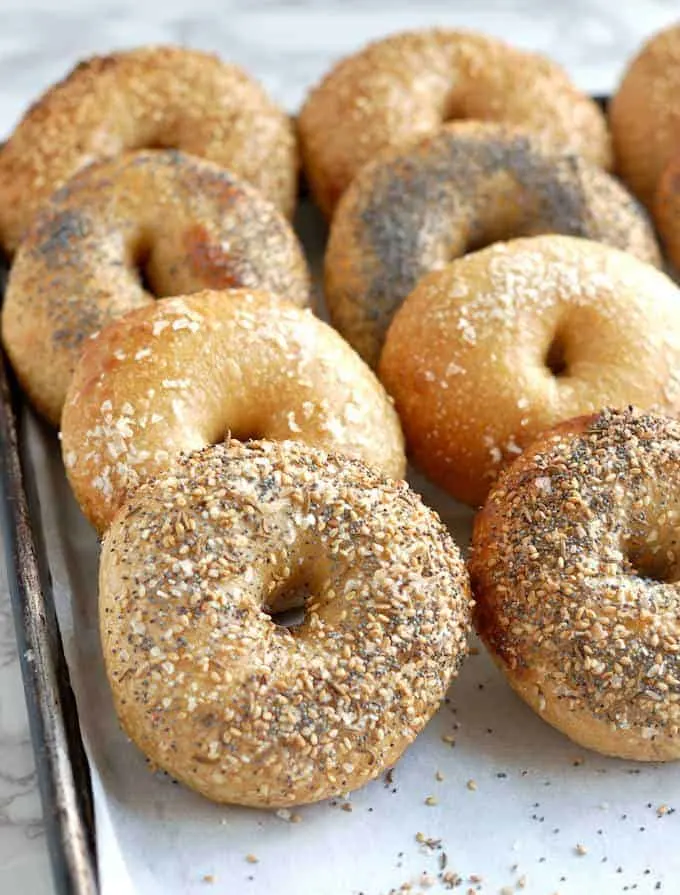
What is a true New York Style Bagel?
I promise you if you follow this recipe correctly you can make a good bagel at home. I mean, there are loads of really bad bagels in the world and life is just too short to eat a bad bagel.
Like a really great loaf of Rye Bread there’s nothing like a true New York style bagel.
A good New York Style Bagel (really, is there any other kind?) must have a nicely dense and chewy texture with a toothsome crust.
To get that characteristic chewiness we’ve got to develop some really strong gluten in the dough.
If you love baking bread and want to understand the process a little better, take a look at comprehensive Bread Baking Guide. It covers the basics of mixing, kneading, proofing, and baking so you can get perfect results every time.
If you’ve got a sourdough starter, you can make Homemade Sourdough Bagels .
Ingredients
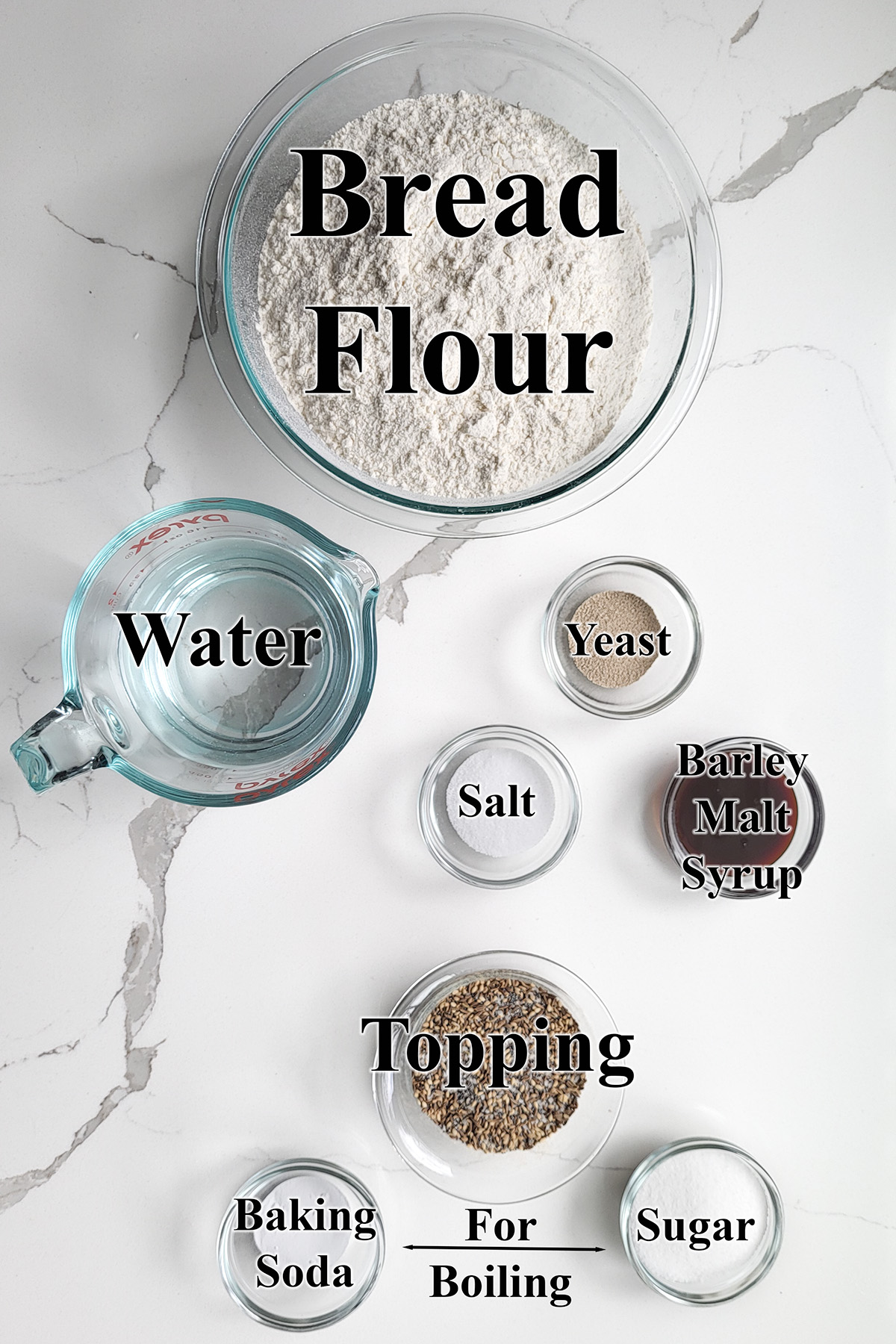
Ingredient Notes
- Bread Flour – Bagels should have a very chewy crumb from a strong gluten network in the dough. High protein bread flour develops plenty of gluten.
- Yeast – I prefer instant yeast to rapid rise yeast for a slightly slower rise. A slow overnight rise gives more time for flavor to develop.
- Barley Malt Syrup – Adds a traditional slightly sweet note to the dough. You can substitute honey or a combination or honey and molasses for the barley malt syrup.
- Toppings – Leave the bagels plain or use your favorite seed for topping. You can mix seeds with salt to make your own “everything” bagel topping”. See the recipe card for details.
- Baking Soda & Sugar – For boiling the bagels. The boiling process creates the specific shiny and chewy bagel crust.
How to make New York style Bagels
See the recipe card for detailed measurements and instructions.
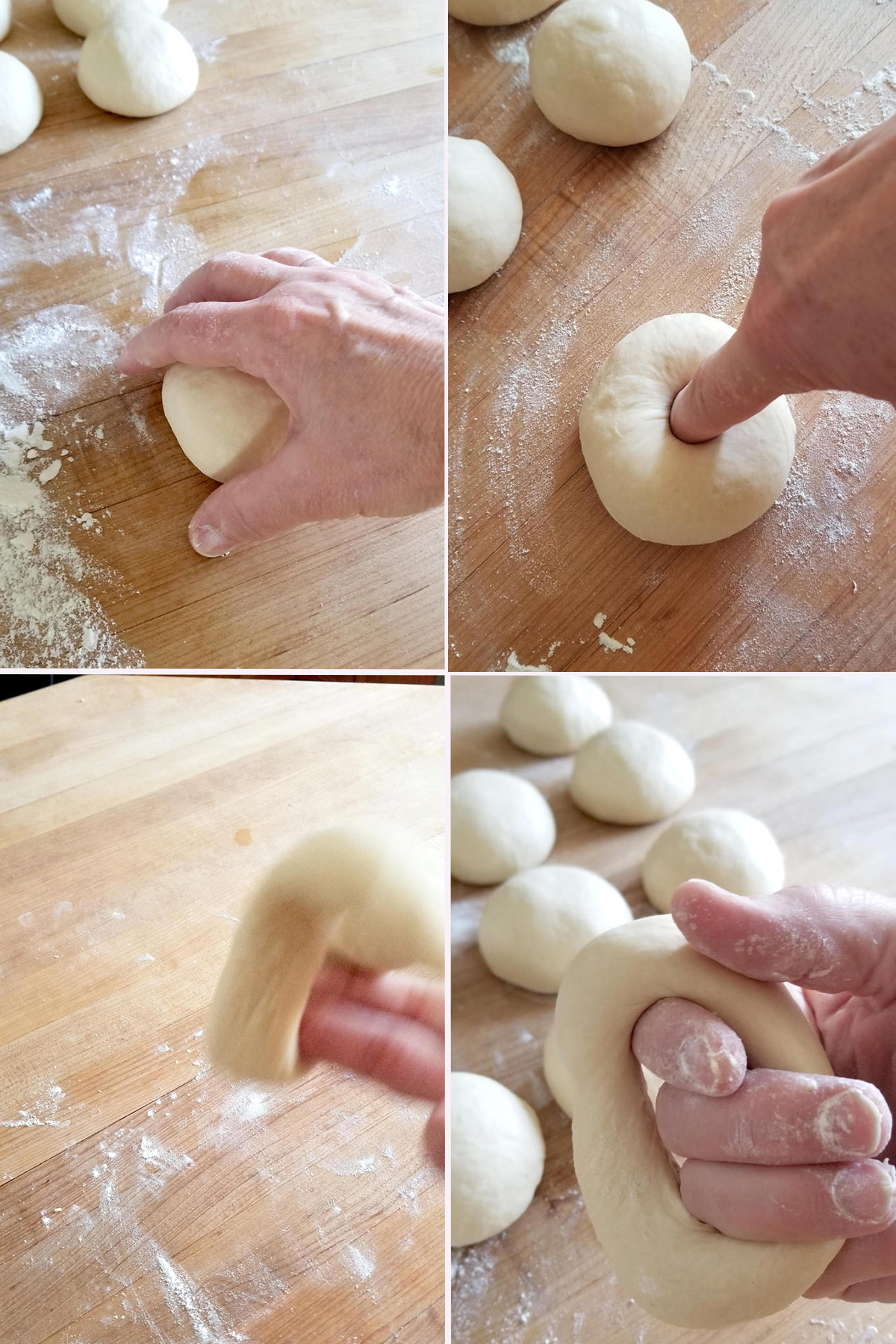
- Use a cupped hand to form the a piece of dough into a smooth ball.
- Poke your finger all the way through the center of the ball to make a hole.
- Twirl the dough around your fingers to widen the center hole.
- Set the bagel onto the baking sheet and continue with the rest of the dough.
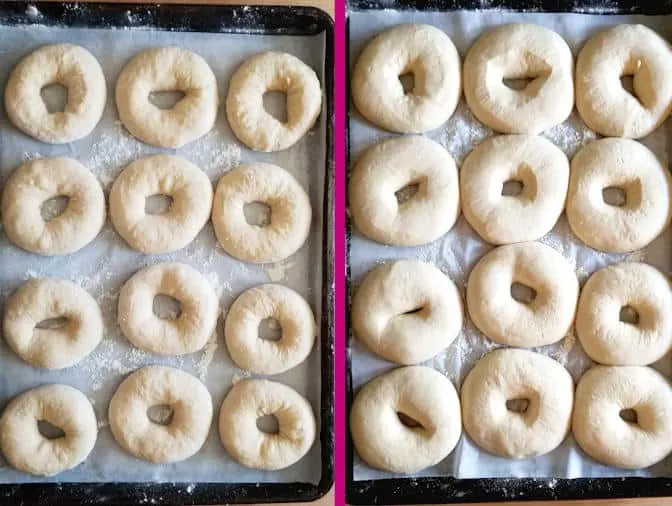
- Cover the pan and place the bagels in the refrigerator overnight.
- If you want to make the bagels the same day set them aside at room temperature for 1 hour.
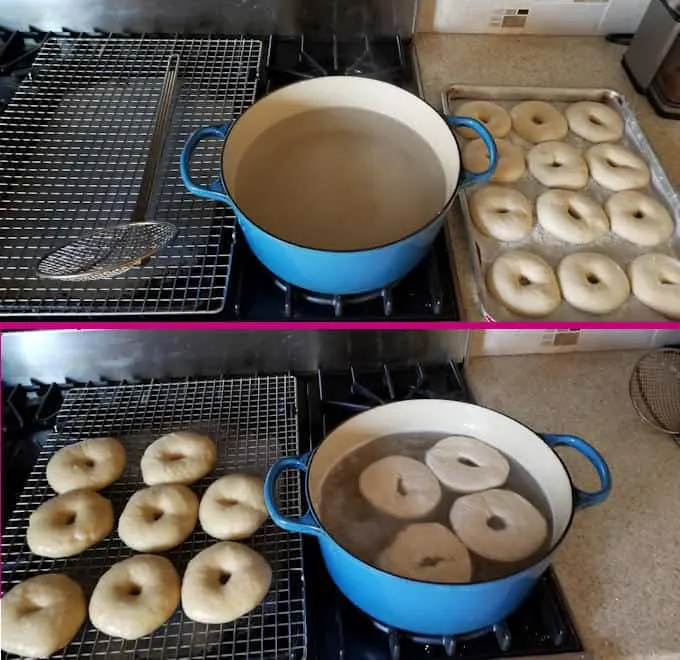
- Bring a pot of water with baking soda and sugar to a boil. Preheat the oven.
- Boil the bagels a few at a time, flipping them every thirty seconds. Boil each batch for 2 minutes.
- Transfer the bagels to a rack to drain while you finish boiling the rest of the bagels.
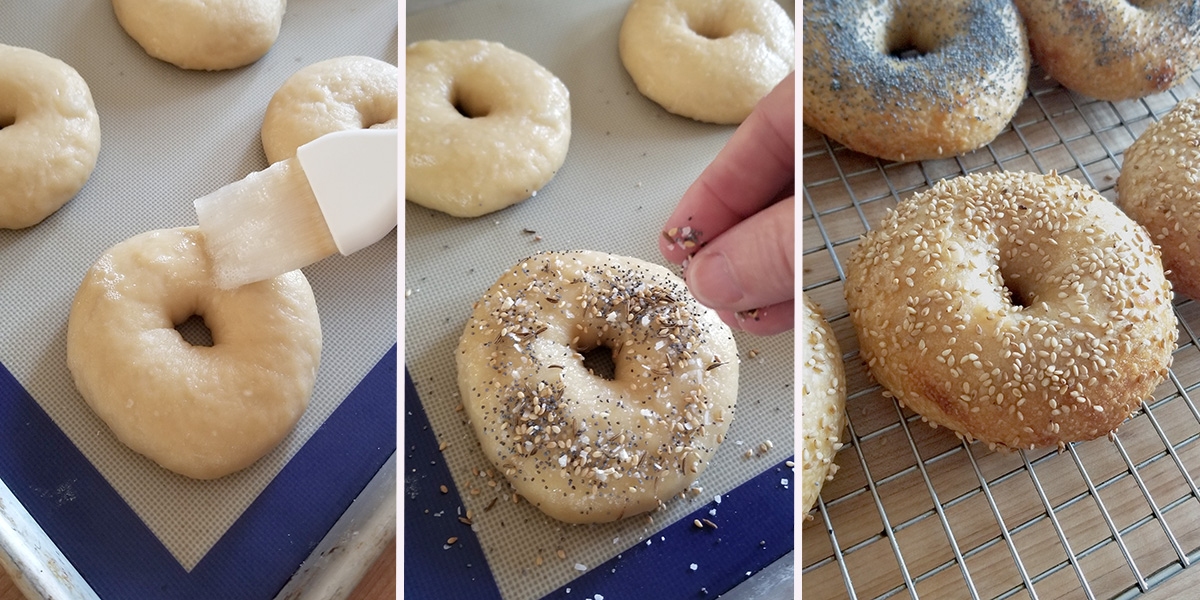
- Brush the boiled bagels with egg white.
- Sprinkle seeds or bagel topping if desired.
- Bake until the bagels are golden brown.
Recipe Tips
- Allow the sponge to rest for 30 minutes before mixing the dough. During that rest the water has time to hydrate the flour and gives us a head start on gluten develop.
- To make the bagels the same day, skip the overnight rise in the refrigerator.
- Bagels are best the day they are baked. For longer term storage slice the bagels about 3/4 the way through and pack them into freezer bags.
- Previously frozen bagels are best if toasted before serving.

You might also like to try these Cinnamon Raisin Bagels.
If you love this recipe as much as I do, I’d really appreciate a star rating and a quick comment. Ratings and comments help my recipes show in search results. Thanks!
Overnight Bagel Recipe
Ingredients
- 16 oz warm water (2 cups (about 100°F))
- ¼ oz instant yeast (2 ¼ teaspoons)
- 25 oz bread flour (5 cups, divided, see note)
- 1 ½ oz barley malt syrup ( 2 tablespoons, see note)
- 1 tablespoon table salt
- 2 oz granulated sugar (¼ cup (for boiling))
- 2 teaspoons baking soda (for boiling)
- 1 egg white (whisked lightly)
- Topping (Sesame seeds, poppy seeds, caraway seeds or coarse sea salt)
Instructions
- In a bowl for a stand mixer or a large mixing bowl combine 16 oz warm water, ¼ oz instant yeast and 3 cups (15 oz) of the flour . Mix to form a thick batter. Cover the bowl and set aside for 30-60 minutes.
- Add 1 ½ oz barley malt syrup and 1 tablespoon table salt. If using a stand mixer, switch to the dough hook. Add the remaining flour and mix to combine. Knead 5 minutes on medium/low speed. If working by hand, stir in as much of the flour as you can, then turn the dough out onto a lightly floured surface and knead in the remaining flour. Knead 5 minutes. Form the dough into a smooth ball.
- Put the dough into a lightly oiled bowl, turning once to coat the dough. Cover the bowl and set aside to rise until doubled in size, about 1 hour.
- Line a half sheet pan with parchment paper lightly sprinkled with flour or sprinkle the pan generously with cornmeal. Turn the dough out onto a lightly floured surface and knead briefly. Divide the dough into 10 even pieces. Use a cupped hand to roll each piece into a smooth, tight ball.
- To form a bagel, poke your finger all the way through the center of a ball to make a hole. Use two fingers to gently widen the hole. Continue gently stretching to form the bagel or twirl the dough around your fingers to widen the center hole (see photos). The hole should be 1 – 1 ½" wide.
- Place the bagel on the prepared sheet pan and continue to form the remaining bagels. The dough will probably spring back a bit so you can go back and re-stretch them once you're done forming all the bagels. Cover the pan with lighly oiled plastic wrap and leave at room temperature for 15 minutes then place the pan in the refrigerator overnight.
- In the morning, take the pan out of the refrigerator. The bagels should be noticeably fuller. Leave the tray out until the bagels come to room temperature, about 1 – 1 ½ hours. The time will vary based on the temperature in the room and how much the dough rose in the refrigerator. Once the dough comes to room temperature the bagels are ready to boil.
- Meanwhile, preheat the oven to 450 °F. In a large pot combine 1 gallon of water with 2 oz granulated sugar and 2 teaspoons baking soda and bring it to a boil. Reduce the heat to keep the water at a rolling simmer. Set a cooling rack over a clean sheet pan and place it next to the stove.
- Lift a bagel off the sheet pan and lower it into the boiling water, bottom side down. Depending on the size of your pot, you can boil 3-4 bagels at a time. Boil the bagels for 30 seconds then flip them. Boil the other side for 30 seconds. Repeat the process again for a total of 2 minutes boiling time. Remove the boiled bagels from the water and set them on the cooling rack to drain.
- Line two half-sheet pans with parchment paper or silicone baking mats and generously sprinkle with cornmeal (or flour). Place 5 of the boiled bagels on each sheet pan. You could fit them all on one pan but they may rise enough to stick together as they bake. I like all the sides to be crusty so I leave plenty of room between them.
- Brush the bagels with egg white. You can leave the bagels plain or add the topping of your choice. To make "everything" bagels combine a tablespoon of each of sesame seeds, poppy seeds & salt with a 1/8 teaspoon garlic powder and onion powder. Adjust toppings to your taste.
- Bake until golden brown, about 20 minutes.
Would you like to save this recipe?
As an Amazon Associate and member of other affiliate programs, I earn from qualifying purchases.









My bagels seem to come out flat even though I followed the recipe to a “T”. I can only get 8 bagels. I put 3 to a cookie sheet for the refrigerator. They rise but tend to spread out. Should I put them on a sheet the way that I do cinnamon buns so that they touch? Will this allow the dough to rise higher?
If the bagels touch in the pan they’ll be almost impossible to pick up and transfer to the pot. If they stick together you’ll have to tug them to separate and then they can deflate. Place them on a well-floured pan with plenty of room between them so they don’t touch. Why can you only get 8 bagels? If you prefer larger bagels that’s ok. But if you divide the total dough by 12 you can have 12 bagels.
I had the same issue with the bagels being flat in the morning. I followed the recipe exactly, and I had great success with each rising and it was clear the yeast and gluten was perfect until the dough hit the fridge. My thought is that in the morning, it would probably help to take the bagels out of the refrigerator earlier, let them warm up to room temperature and let the yeast reactivate to puff them back up a bit, then put them into the water. As it is written, the cold bagels cause the water to stop boiling even with just three or four bagels in it. Just a thought.
Hi Jeff, looking at the way I wrote the instructions I can see the confusion. I rewrote it to be more clear. The intention is that the bagels sit at room temperature for some time. They can sit out longer if need be.
Hello.
Not much experience at baking but I’m looking forward to giving these a shot! It’s been really hard to find yeast these days but a thoughtful neighbor gave me some active dry yeast. Your recipe calls for instant yeast. What additional steps will I need to take with active dry yeast?
The recipe should work as written with active dry yeast. If you want to be sure the yeast is good, in step one mix the yeast and water with a 1/2 tsp of sugar. Set it aside for 20 minutes to make sure it bubbles up. After that proceed with the recipe as written.
I’ve been spending quite some time looking for a good Bagel recipe having grown up in Jersey and NY. I’ve noticed a common theme with the Barley Malt Syrup in the dough, but another recipe I found uses the syrup in both the dough and in the boil. What are your thoughts on using the syrup vs. sugar?
I think you could use either in the boil. But definitely the syrup in the dough.
Hi. I am from Long Island and these taste just like my local bagel shop, thank you.. But as a few others have stated the bagels go flat while being covered in the fridge. Are you using cling wrap? I feel that the wrap is preventing them from rising even though they are loosely covered. Maybe they should rise in a deeper dish? I use the scoop method. I let proof for 60 minutes and then rest for 15 minutes before the fridge. Would a longer time cooling in fridge (16+ hours) cause them to flatten? I had to reshape into a ball after fridge cooling, poke a hole and then rise again at room temp in order to get better results. Otherwise they turn out to be flagels
Hi Mark. I place the bagels on a parchment lined sheet pan which is well-sprinkled with flour. Then I cover the bagels with plastic wrap. I’ve had the bagels in the fridge for more than 12 hours. Are the bagels still flat after boiling and baking? What do you mean by the “scoop” method? Are you referring to measuring the flour? Is the 60 minute proof you refer to for the sponge at the beginning of mixing the dough? When you say the bagels go flat in the fridge do you mean they are flatter than when they were shaped? Like the actually deflated. Or do you mean they just haven’t risen enough?
They rise in the fridge until they hit the cling wrap. Then they seem to flatten. Even if I let them rise a bit before boiling they flatten. I try to handle gently but they are very fragile
Does the dough have nice gluten development? Do you find the bagels are nice and springy when you’re shaping them? The dough should be springy enough that you may have to go back and give them another stretch to reopen the center hole. If the bagels have good gluten development I wouldn’t expect them to flatten from hitting the cling wrap. You are using bread flour, leaving the sponge for 30 minutes and kneading 5 minutes?
Yes to all your questions. They are very springy. Holes close up. I am thinking just a bit less water. Thank you for getting back to me. Again I will say that the taste is excellent. Thank you for the recipe